#walter follows her into a cult knowing she's killed someone
Explore tagged Tumblr posts
Text
love how the men in yellowjackets (mainly jeff and walter) are just. extremely cool with their girlfailures having committed murder they're just THAT down bad. jeff is like oh cannibalism? ritualistic murder? idc babe whatever you need I love you so much while walter is like *desperate for mistussy voice* it's fine it's FINE that you're a serial killer my grandma was a killer too see we can even bond over it here take all my compensation money can I hit now can I hit. pretty please 🥺🥺🥺🙏🙏🙏
#yellowjackets#they're INSANE#walter follows her into a cult knowing she's killed someone#jeff is like i can accept you having vored our ex girlfriend but i draw the line at no book club
67 notes
·
View notes
Text
hello little gay people who live in my phone, here are my thoughts on yellowjackets 02x03. spoilers below cut
first of all! lets talk taivan bc i feel like we got some good stuff from them this week so i’m starting there bc i love them
- i felt so bad for tai when she had the realization of what happened. like she had no idea and it’s so upsetting like she had to process that not only did she do that but everyone else did it willingly! also how van just immediately tells her that she ate the face, van, baby, i love you but maybe don’t immediately tell your gf that she ate someone’s face in her sleep. also interesting to me that she went for the face given that in 02x01 she tries to eat van’s face in her sleep
- van following tai when she sleepwalked, she’s so so so worried for her and i feel like in this episode she really fully sees how bad it is. finding out about the man w/ no eyes, sleepwalking tai not being tai, it’s all super wild and i want to learn more i wanna know what her connection to the supernatural is and being drawn to the rune was interesting
- during the bird scene when van was collecting them like lottie said, the way tai was looking at her made me sad. like we know the cult shit is causing issues between them but i don’t like seeing it. i do think i read somewhere that tai ends up getting more into it to stay closer to van so that’ll be interesting to see
- ok now onto the big moment for the taivan girlies: THE FUCKING MIRROR SCENE i’m obsessed mirror tai mouthing “go to her” and forming the doomcoming mask with her hands oh my god i can’t. and then her immediately running out at taking her assistant’s (or advisor or whoever that lady is) and calling jessica roberts (rip). i wanna know how she ends up finding van cause we know jessica can’t help anymore but yeah just the desperation to go find her in that moment was a lot for me and i cannot wait to get adult van next week
alright now onto some more general thoughts that aren’t taivan
- once again feeling terrible for our doomed king, ben. the scenes where he was remembering paul and imagining having gone to him instead of getting on the plane… my poor guy :( also him hallucinating rabid gen was great and honestly valid. at this point i honestly feel like ben’s gonna end up killing himself, whether he just like stops eating or like full on commits suicide i honestly think he’s just gonna die then get eaten rather than being killed for food
- i loved the scene of nat just staring at jackie’s body. her guilt and shame was so clear and just demonstrated well between that scene and what she said to the bones after dropping them off at the plane
- i don’t trust walter. the way he instantly jumped to flattering misty in exactly the way that works on her makes me suspicious and i wanna know what he’s up to. other than that mostly didn’t care about him and misty’s shenanigans except that its leading them to lottie and therefore our mistynat reunion
- lottie telling shauna that jackie would’ve wanted shauna to eat her and shauna saying she wanted to eat her… the homoeroticism of cannibalism my beloved
- loved loved loved the bits with akilah this episode, her and tai talking, her talking about her nephew, it was just SO sweet and so wonderful and i love her
- misty and crystal agreeing that jackie was tasty, crystal telling misty about absorbing her twin in the womb, these two are enabling each other’s weirdness and i’m obsessed with their loser girl friendship
- nat hallucinating the moose was interesting bc she’s one of the few main girls that hadn’t hallucinated yet so wonder what that means
- listen. shauna threatening the dude was incredible, i love my unhinged milf, but like the car theft thing took up too much time and also we got too much jeff this episode
- misty’s gift at the baby shower killed me. loved nat, tai, and van talking shit about it that was great but like what the fuck misty why are you like this
- adult lottie seeing the hives bleeding and bees dead was really interested and i wanna know what it means
overall a pretty strong episode. i’m glad that in the wilderness they had a fairly chill time given everything, like we don’t need a big shocking scene each episode and this one was more about dealing with shit and i liked that. my biggest issue this week is, as many people are saying, too much men (ben is the exception bc he’s the only man on this show i really care about)
15 notes
·
View notes
Text
The Mask 1994
*I finally wrote the whole thing. I finally watched the movie that involved something I’ve been talking about A LOT. I think this took about an hour since I finished the movie. Forgot to mention Charlie.*
I wanna make this clear, even before I watched movie or ever writing this. I am legitimately a stupid and lazy person. Because my mom told me about this, and last week, my dad rented A Quiet Place Part 2. When I was trying to go to sleep but was looking up movies...I literally forgot my tv can do that too...and that I can rent or buy a movie...I rented the movie this morning, and deleted it afterwards...after all that talk...I could’ve done that...wow. I should do that more considering some movies I wanna see or like. Not too much though. My tv has DirecTV. Just a heads up.
But a few or couple of minutes ago, I finally watched The Mask film from 1994. This post is gonna be filled with spoilers and it’s gonna get long. Gonna be kind of a review. My overall thoughts on it. This was my first reaction to the whole movie.
I’d just wanna talk about this too. I like comic books, I like comic book movies. Mainly my favorites are ones like all of Zack Snyder’s DCEU movies, Spider-Man 1 & 2, The Suicide Squad 2021, Wonder Woman 2017, The Dark Knight(Despite whatever issues I have with it), and Joker 2019. Yeah, those are mainly DC films and two Marvel related ones. I don’t even mind Spider-Man 3 as well. I also forgot Dredd 2012 is another one of my favorites. Along with Batman 1989.
I was hoping The Mask could make that list of favorites. Because I read the comics first. I don’t think I ever watch the movie fully as a kid MAYBE. I’m a fan of the comics, I know this movie was gonna be a lighter take on the series.
In a nutshell...I liked it. It’s possible it will be on that list of favorite CBM’s...but I want to talk about it. I’ll also admit I think what got me interested in seeing this film and this series was me liking Jim Carrey as Ace Ventura...now, let’s get to the point.
Yeah, I liked it. I thought the movie was genuinely entertaining. Despite seeing some clips before. But also Ryan Hollinger’s video about it. Revealing the ending, the twist, and other stuff. But I didn’t wanna watch more more that I haven’t seen yet.
I will be honest, it still made me laugh. Even some scenes I already have seen. I will admit, the Cuban Pete scene is actually one of my favorites. XD But what also surprised me is that at times, despite being a funny film. It can genuinely be touching in a way. And I am mainly talking about the developing relationship between Stanley and Tina.
I just wanna talk about the characters right now. I’ll just admit unless I haven’t already. I’m a Jim Carrey fan. Mainly because of his more goofier roles. Particularly his roles from the Ace Ventura movies, Liar Liar, and especially Sonic The Hedgehog. I also will admit this, Jim Carry nails playing Big Head or who they call...The Mask in this movie...I’ll nitpick about that later.
But yeah, Jim’s entertaining as Big Head in this film. He does make me laugh. But I think another role he does well despite there are some sillier moments, which is fine. I feel like in a way, Stanley Ipkiss in this version, is maybe one of his more normal roles. But I know I’m wrong considering whatever other roles he’s in. He portrays a likable good guy who’s sadly mainly pushed around. Which is quite the difference from the comics, except being pushed around. But that’s another topic. Yet for this story, even if maybe Stanley’s name could be changed. But him being a genuinely kind guy works for this story.
Even before I saw the movie, learning more about this version about the character. I can relate to Stanley in some ways honestly. Which is something that I like. He basically shines as a protagonist.
He portrays both sides well. Despite at times...honestly, this Stanley is wacky. I shouldn’t be judging. Jim does a good stuff with what he played, and he’s the highlight of this movie. He also delivers possibly my favorite Jim Carrey line of all time now. Sorry if I get this wrong. I was looking for a clip of it to help me.
“Daddy’s gonna go kick some ass”. A literal line from Jim Carrey in this movie and I love it. He even brings a pistol with him.
I also wanna admit Peter Greene as Dorian is pretty good as a villain. The dude can be threatening and he works with what he is given. And he’s effective as an antagonist. I just wanna admit that I swear, one of these guys. One of them could’ve Walter in a way and I just think that could’ve been possible. But I’m not sure. Just one of Dorian’s henchmen looked like a huge guy. It just got me thinking about Walter from the comics.
Will admit, I think Kellaway is fine. And I just found out Christopher Reeve was one of the actors considered for the role...damn. But again, Kellaway was fine. He’s more like a supporting character and again, this is like an origin story. I do feel bothered Lionel Ray wasn’t added but replaced with this Doyle character. I will admit that Doyle is silly, which is the point of his character. I guess the writers and director didn’t want two sensible cops or something. I like Kellaway alright, but I’ll always dig Lionel too.
I really wanted to get this point. I thought Cameron Diaz was good as Tina Carlyle and Amy Yasbeck as Peggy Brandt. I will admit, I do strangely like the subversion with Peggy in a way with it’s twist. I get the idea if that it was going for that theme of, “We all wear mask” and Peggy turning Stanley into the mob said a lot about her character. While Tina was genuinely the one that truly supported Stanley.
I think was surprised me more was the fact despite Peggy turned in Stanley for selfish purposes such as paying for her condo. Yet what surprised me more was she was actually concerned for Stanley being killed, and didn’t want him hurt...which explains even more why she stuck around in the cartoon. And honestly, it makes me glad the director took out that deleted scene of her getting killed. So she wasn’t that heartless.
Also...it made me think that...my ideas and changes towards her character...maybe hold some weight.
I’ll just put this out there too. Milo is great, one of my favorite fictional dogs maybe. Good dog.
Trying to think what else, the score was fine. But the licensed music was good or something. Overall, I think my negatives could be just...nitpicks. Such as the Big Head part I wanted to talk about. Listen, I understand this is a different version. I just feel it’s weird to call him, “The Mask” instead of Big Head. I know other characters mask in their name or something. But...some reasons, the name Big Head is there. I guess it’s because of the title or something.
Honestly, I think my negatives are more that it feels short. And maybe Stanley becoming Big Head a bit too early. I sound kind of stupid, I know. But this was the 90′s and whatever else. This was a different take on the comics. But I did genuinely like it. Maybe I’m just a bit attached to those comics. Despite knowing the changes they did.
But I will admit, considering the development for this film. And learning that it was meant to be a horror film. But the director Charles Russell found the violence in the source material to be off putting. So he made it less grim, and more fun. I’ve also read somewhere that trying to make comedy with that violence was difficult.
Back to the point, to be honest. I feel like for that time and age. A more light Mask film was maybe the best choice to go. And we wouldn’t have Jim Carrey in it. I do also wanna say, I feel like The Mask series, you can do a lot of it. You can have something dark with it, or maybe more lighter.
There are still some of those darker elements. Mainly considering the moments with the gangsters and all that. But I will admit, learning that Charles mostly directed horror films. I think it’s impressive he made a more family friendly film and it worked.
I liked it, despite my love for the comics. I thought when writing this, maybe some folks reading this may think I sound like fans who read the comics who first experienced this movie. But the film isn’t bad, it’s just a different take and a pretty nice one at that.
And to be honest, as much as I would of loved to see an actual sequel. And not that bad film known as Son Of The Mask. I understand why Jim Carrey dropped out, and I would’ve loved to see Peggy back because the director planned to bring her back reformed. But I feel like this film works as a one off in a way. And there’s also the cartoon, which works fine as a sequel despite some differences. Yet...I’ll admit, I would’ve loved The Mask 2 if we got Jim Carrey as Stanley again fighting against maybe someone like Walter.
The Mask 1994 is a good film. Despite changes from the source material, but the changes for this vision work. It’s cool this film has a cult following, and the fact I have used elements and story beats from it for The Mask Rebirth stuff I’ve been talking about. Even before watched this whole movie.
It’s a genuine fun flick. But I’m hoping down the line, if Warner Bros stops being fucking stupid with how they run things. Maybe we’ll get a reboot or how about an animated film that seems more true to the source material.
I know The Mask/Big Head doesn’t have a big legacy such as the likes of Superman, Batman, and Spider-Man. But I do think this series could be reimagined and expanded upon. Using elements not only from the original comics, but even the movie and cartoon.
And...despite it was because of Ace Ventura...I would like to thank @kaijuguy19 for being such a supportive dude, and talking about this franchise with me. Including wanting to talk about this movie long ago when I haven’t seen it. But I want to say...no...he’s one of the big reasons why I’m a fan. Because he’s one of the only guys I know who’s a fan. It started with Ace Ventura, but it was because of talking with Kaijuguy that I guess things started to escalate. So thanks man for talking about this stuff with me.
Also, Charlie was silly and he was fine as a character. I forgot about that dude despite wanting to talk about him. Gonna tag him too in case. Charlie schumaker
#GeekGem Rambles#the mask#the mask 1994#jim carrey#stanley ipkiss#dorian tyrell#mitch kellaway#tina carlyle#peggy brandt#cameron diaz#amy yasbeck#peter greene#big head#charles russell#charlie schumaker
39 notes
·
View notes
Text
Babylon Berlin, S3Ep8
Fall in the Great Outdoors. (Remember when we could go outdoors?) What’s not to love? Beautiful colors, crisp air, forboding fog, and a murder...

Following the cult of fitness as usual, Wendt is out riding a horse until he happens upon a distressed Richard. He confesses that Rath has found his real identity and wants a favor to get away. If the police found him, surely everyone else will be implicated next, right?
Really leaning into this Bond villain thing, Wendt casually offers Richard a cigarette and asks if he told anyone else. No, Richard replies, he came straight to Wendt. Satisfied, Wendt pulls out a gun and shoots Richard twice.
A reporter at Tempo delivers the updates to the movie mystery over a nice montage. Walter is unconscious and in police custody. Gereon is recovering, too. It almost feels like the end of the season. Things are wrapping up rather neatly...too neatly.
Ester can’t believe Walter did it, but Edgar is quick to pin the blame on his partner. To convince Edgar of Walter’s innocence, Ester shows him a one-sided coin that Walter had tossed with Edgar over who would go to prison last year. It does open Edgar’s eyes, not to Walter’s innocence, no, to something else entirely...

Where did you get this coin?
Gereon (with only a little bandage on his face and a few broken ribs) discusses the case with Lotte. Seeing she is distraught but not quite understanding why, he tries to comfort her.

Helga enters at the wrong (right?) time and sees this. Lotte quickly scuttles off so Helga can tell Gereon her news. Far from excited about the pregnancy, Gereon immediately suspects Helga has been unfaithful. She reassures him of her fidelity. Gereon shoots back with the memory of Anno. And on that ugly note, the relationship is irreparably over for good. Helga storms out.
As serious as this scene is, I just want to remind you: this is a shared ward. There are other patients in the room watching this entire argument! I’d love to know what they think is going on!
Helga considers getting a back-alley abortion from none other than Lotte’s neighbor, but she begins to change her mind. Abortion was illegal at the time, and Helga’s Catholicism also makes her hesitate. For now, the two women will simply talk about the procedure as Helga makes her decision.
Like in the first season, the nationalists are out hunting deer. Moritz can’t bring himself to shoot the deer and misses. The boys taunt him for going soft until Moritz gets into a fight with one boy in particular. Otto interrupts the fight and tries to convince them that they have other enemies (cult pitch number two). He makes them swear allegiance.
We know it’s wrong.
Moritz should know it’s wrong.
But he is desperate to feel like he’s capable of more, and it gives him the sense of purpose missing in his life.
Greta, too, thought she had a purpose. Now with the date of her execution set, she resigns herself to the end. She finally confesses to Volker that the communists were not behind the murder plot. Volker seems like she’s about to deliver her own admission of a backstory when Greta interrupts.
Nothing could have prepared Volker for what Greta does next.
She asks for a hug.

(And we all started crying).
But there’s little good the truth can do for Volker or the rest of the communists in the prison. There’s little good the truth can do for Katelbach, either, at the moment. Now that his article is out, he lives in fear or reprisal.
The political police have called him in on charges of treason. Elisabeth dismisses the treason charge as nonsense. Katelbach hasn’t done anything wrong. She tries to make him see the bright side of the situation—he has all the peace and quiet he could possibly want and plenty of time to write while staying inside all day.
(I picked a bad time to watch this episode.)
But something more serious slips into her tone. Hiding in fear is no way to live, and neither is living in a mess of a room, smoking all day. He’s getting a little old for the bachelor style.
And then a switch goes off in Samuel’s mind. She’s not...proposing, is she? “Think about it,” she says, leaving Katelbach to process this information. He immediately moves to put his cigarette out and tidy up.

Malu and Wendt run into each other during lunch. (I guess if we’re given the gift of Samuel and Elisabeth, we have to suffer through some unsavory couples...) It seems he has taken Nyssen’s speech into consideration. He asks Malu about her opinion. She comes to the same conclusion as Nyssen, albeit from a different angle.
This talk convinces him to give Nyssen another try. All Nyssen has to do is get collateral from his mother.
But while Nyssen has millions to throw away on a theory, Lotte and Ilsa can barely save up enough to secure an appointment for surgery. The doctor’s assistant points them in the direction of a relatively cheaper doctor who can take Ilsa soon, but the operation still requires more money than the two women currently have. Lotte knows only one way to make a few hundred grand in one night.
(What this episode says about poverty...)
For all that Lotte is doing to help her older sister, she is unaware of the danger her little sister is about to face. Left alone while her sisters are at the doctor’s, she talks to a character I think we’re supposed to recognize, but I can’t place him. (The bird seller from a previous episode? One of her brother-in-law’s friends?).
It becomes clear to everyone but Toni that this man does not have her best interests at heart. He plays on her sympathies, trying to invite her home to “read to his uncle.”
(I wanted a reference to Fritz Lang’s M, but I was thinking of a sweeping city shot or a music motif, not this! Never this...)
With Lotte unaware of Toni’s plans and Toni unaware of Lotte’s plans, the girls see a movie with Betty Winter. While Toni stares at the screen, transfixed, Lotte begins to weep. It’s Vera’s face she sees on the screen.

(This is the second time she’s broken down sobbing in the middle of a movie...)
After the show, she goes to earn the money for her sister’s operation as fast as she can—by going back on the game. But this isn’t lady’s choice like Moka Efti. She emerges from the session with tears in her eyes.
She really can’t catch a break, can she?
Meanwhile, Gereon wakes up in the hospital with Edgar sitting by his bedside. He wants to make absolutely certain that Walter is responsible for betraying him, but he also wants to intimidate Gereon into agreeing to work with him once again. Referencing Helga should do the trick.
“She’s not my wife,” Gereon replies. Edgar shrugs. Far be it from him to criticize a stranger for their love life, especially when his is about to get stranger.
But this entire conversation turns out to be a distraction as Walter is abducted.
It’s time for...

FRANKENWALTER!
Dr. Schmidt hooks the unconscious Walter up to an electroshock machine for revival and cranks the charge up to a dangerous level.
Walter reveals that he was tricked. The Phantom pulled the old two costume switch-a-roo to fake his own death and dispose of Vera. Before he can reveal the identity of the Phantom, Walter begins to recede into unconsciousness. He revives for one last confession: he loves Ester.
Edgar storms home to confront Ester about her supposed infidelity when the police arrive with a warrant to search the premises.
Notes:
For failing to kill the deer, Moritz is taunted and called Bambi, the eponymous character of the 1932 novel by Austrian author Felix Salten. (The animated film came out in 1942.) Like many of the authors referenced in this show, Salton was hated by the Nazis because he was Jewish. His books were banned, and he fled Austria soon after the annexation in 1938.
Moritz gives his age as fourteen. (I know some kids grow faster than others, but it’s still hard to believe that this kid grew an extra foot over one summer.)
Continuing the trend of horror references, Walter’s revival is one big allusion to James Whale’s adaptation of Frankenstein in 1931.
Helga walks by a kiosk that includes some nice expressionist art. It looks like a copy of a woodcutting. I can’t tell if it’s Karl Schmidt-Rottluff or Otto Dix or someone else entirely. Does anyone recognize it?

14 notes
·
View notes
Photo
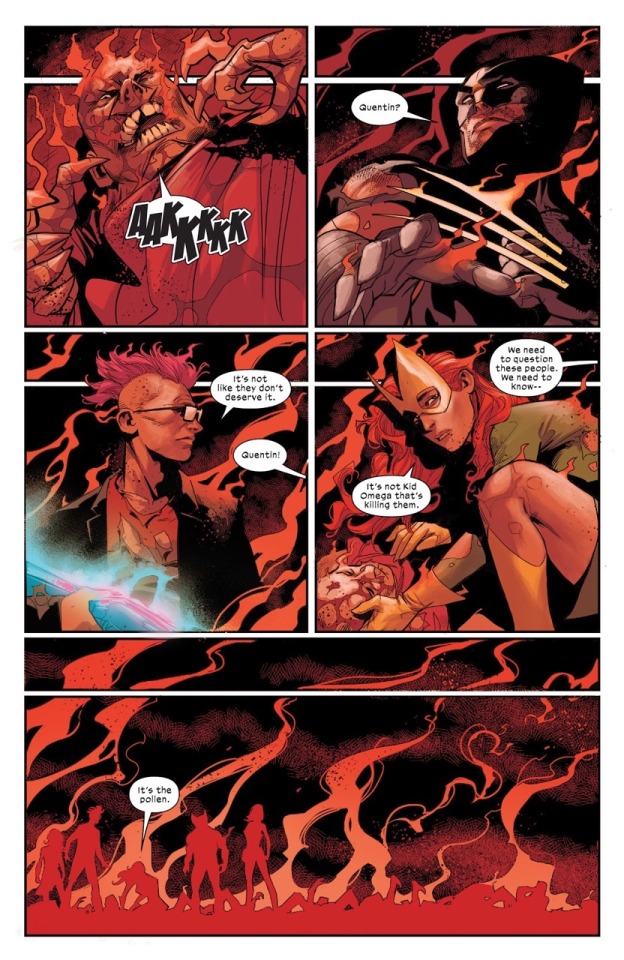
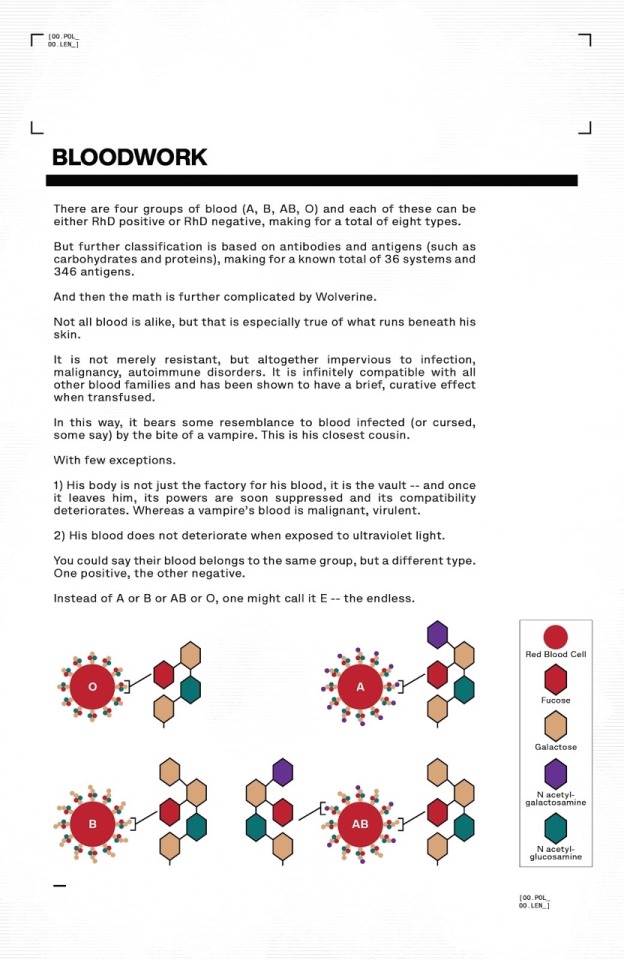
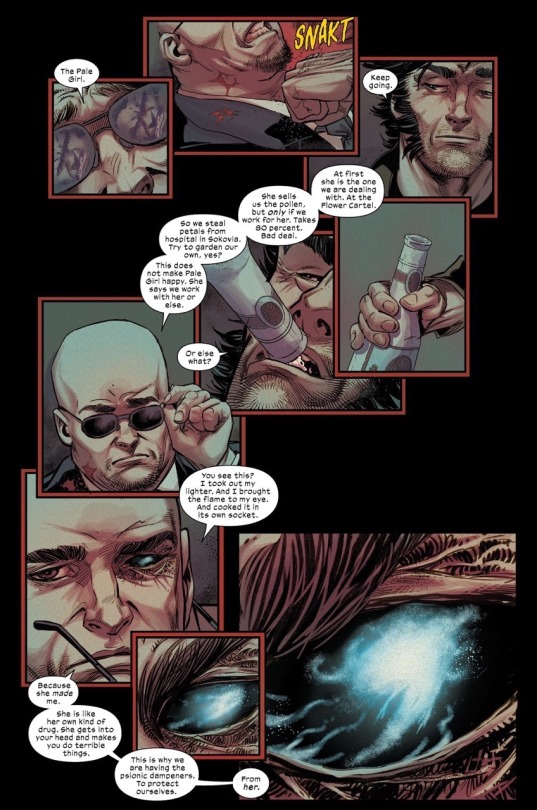
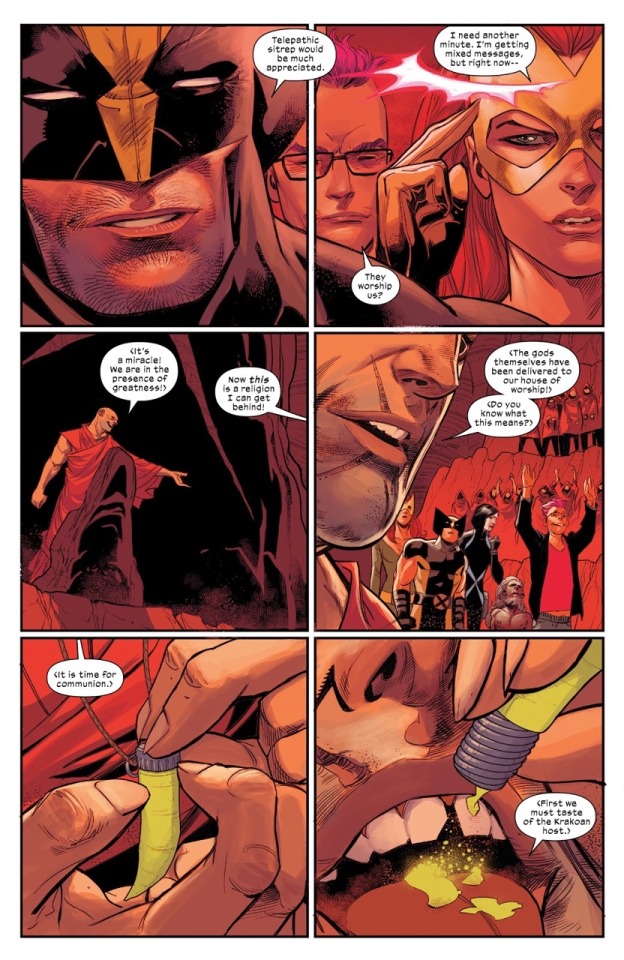
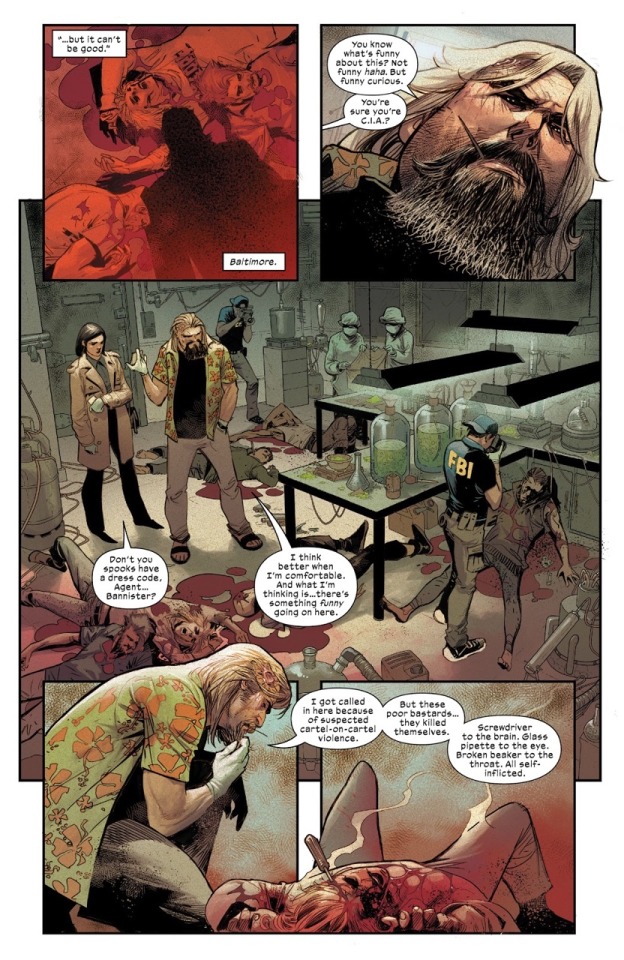
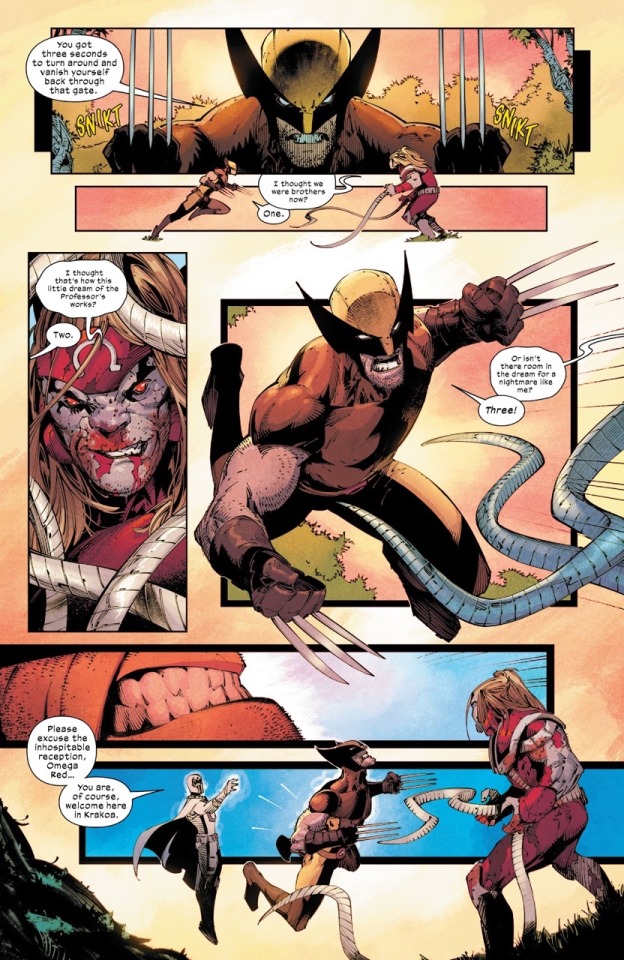
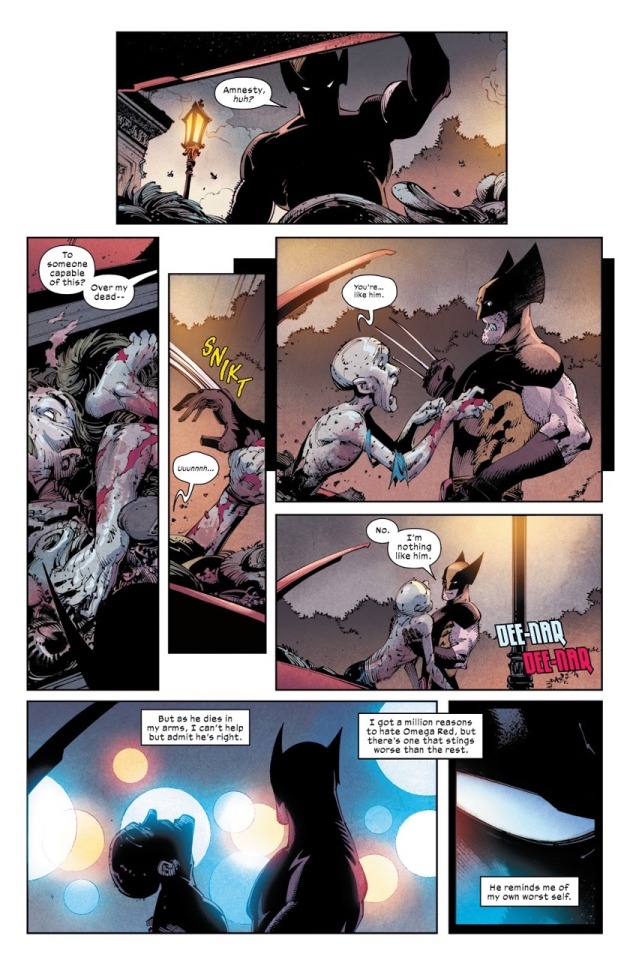

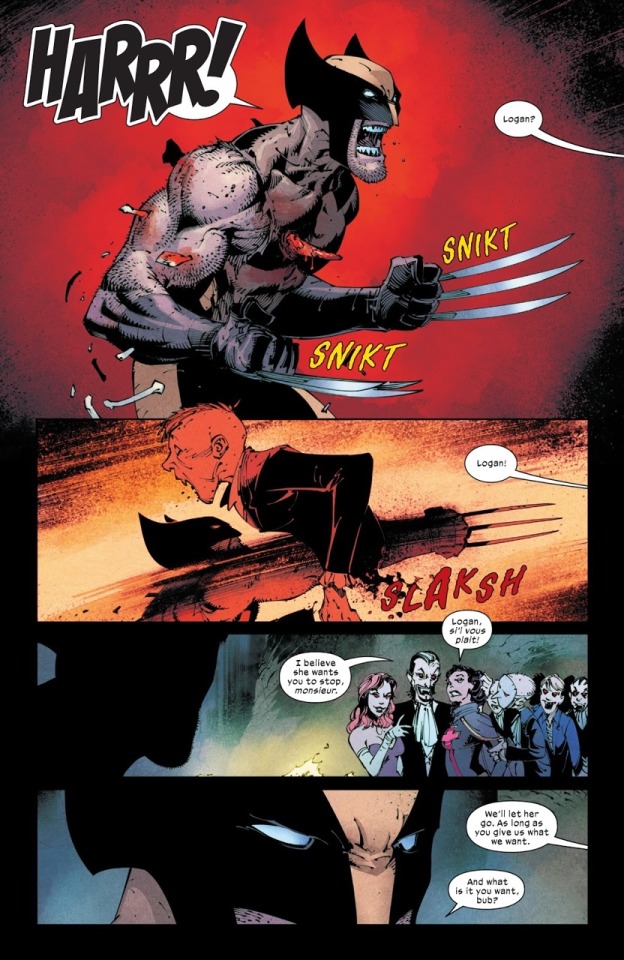

Wolverine #1
*Spoilers*
The first story starts somewhere in Alaska, where Wolverine seemingly has killed Jean, QQ, and Domino. He starts tracking foot prints in the snow.
Five days before Logan is playing 'hide and seek' with some mutant child, when Jean rats out his hiding spot out...(Not cool, Jean...five year olds everywhere are shaking their heads...)
Logan meets up with Kitty and she talks about how he seems happy; Logan shrugs it off and asks what is the real reason she is here. We find out a shipment of Krakoa medicine is regularly going missing.
In Baltimore, a shabby CIA agent stumbles upon an possible 'suicide' case (in the LEAST looking suicide method possible!) and finds drugs that are clearly the missing Krakoa drugs.
Remember how during the 'X-Force' review I said a cult worshipping mutants sounded like a cooler villain than what we got ? I may be getting that wish fulfilled in this book...
We find out the petals may have ended up in Russia; Logan sends X-Force down there. (with a non- plant-y Domino, I might add!)
We find out the Baltimore C. I. A. Agent has a sick daughter waiting on those petals for her treatment.
Logan's blood is compared to a vampire...(🙄)
They track down the cult in Russia, where QQ runs head first to meet his 'followers'...( you would think telepathy would CAUSE HIM see how terrible an idea this is...) ...
Before almost getting eaten by the cult!
As the fight ensues, suddenly the cult drops dead- poisoned by the flower they had ingested minutes before.
Logan tracks down the dealers that sold the cult the petal laced drugs, in a bar in Moscow; it turns out they are hiding from a pale girl. (I'm going to laugh my ass off if Maxime is the new 'Walter White'! 😂😂)
Sadly as we cut forward, we see the 'Pale Girl' as an apparition in the snow (And sadly not Maxime...), just as Logan is surrounded.
The second story starts with Omega Red wanting amnesty. (Ugh 😕- I'm going to be upfront- for every GREAT X-Men villain like Magneto, Shadow King, Mystique, Sinister...there's Omega Red, Nanny and Orphan maker, and Sugar Man... Omega Red is one of those villains I just...really cringe and dread reading about every time he pops up in a book. I actually prefer Arcade to him...because at least vintage Claremont Arcade...was entertaining. I've just NEVER really gotten why X-writers use him because he's just such a one note boring villain.)
Logan is about to attack him, when Magneto tells him to essentially knock it off...(Because it totally isn't reasonable to question if he's working for the Russians after the attack on Colossus...)
Magneto drops Logan off through a portal to Paris, where Logan finds a trunk full of corpses who were seemingly Omega Red's prey...
Back on Krakoa Magneto reiterates the rules of amnesty for all, (There is something HEAVILY wrong with a Jewish character citing Nazi scientists as an example) and tells Logan to investigate it while Red is kept in a cell.
Logan investigates a bar, (Aka goes to get a drink...) and is sedated.
We find out that vampires are the culprit, (If the vampire/healing factor drop earlier in the first story wasn't a clue...) and Logan is saved by the mysterious woman/Tyger knockoff selling flowers earlier...
Back at Krakoa, Omega tells Logan the story of Saint Julien...(How you mistake two old people for your wife sleeping with another man, I will never know 😂😂...Just in CASE anyone reading this review had a prophecy foretold about you murdering someone....the MORAL of this is just DON'T murder people! Don't be to stab happy and it probably WON'T even happen...)
At St. Julien le Pauvre, we see the mysterious woman/Tyger knockoff and discover her name is Louise. We find out vampires are using the distraction of Krakoa to rise up...(You got to hand it to vampires...they are at the very least industrious!)
Logan and Louise fall in a pit and get surrounded by vampires...and they all bite Logan.
The issue ends with Dracula able to go out in the sun because of Logan’s blood, and using Omega's desire to no longer kill to survive, to have him spy on Krakoa...
Opinions:
Honestly- I found myself regularly putting this issue down and doing other things (Although part of that was Coronavirus/work related!).
I found myself also debating about doing a two part review...but honestly, I don't really think I need to.
It's just rather mediocre Wolverine stories and frankly I kind of question why Marvel even DID this book when the current X-Men line is already SO BLOATED; other than it's Logan and Logan sells.
It's sad, because I ACTUALLY DO like Logan when it's good storytelling; but this is a story we've heard from better writers before.
I'm kind of surprised they did vampires again...since the LAST time the X-Men mixed with vampires we got vampire Jubilee/Cyclops telling Dracula to 'Follow his heart'.... So far...the writing seems to be on the same rather shitty level...but without the, 'So bad, it's great!' moments....
Theories:
Honestly... I'm probably not even picking up issue #2... This last one was just SO long...and really BORING...
7 notes
·
View notes
Text
105 Hill Top Road: What the Fuck
(Relevant episodes: 008, 019, 043, 055, 056, 059, 067, 078, 089, 114, 130, 134, 139)
I mean, I think it's pretty obvious at this point that Anya Villette came from another reality, right? The timeline's different but the Powers are the same. At least one of them, with that spidery tree. She goes into the house in one reality and wakes up in another one, where all her friends tell her, "oh yeah, when shit like that happens to you, you go to the Magnus Institute," and she says, "the what now?" And there's this building in Chelsea that wasn't there before and they take her statement and then she...what? Does she disappear? Do the spiders get her? Or does she just not have a legal identity in this reality so that's why they can't find her?
(Did Gertrude actually read this statement? She's probably busy as hell in 2009, she's been working on rituals, Mary Keay has just turned herself into a book, Leitner's running around in the tunnels. And she was skeptical of Dekker's theories; would she be as skeptical of something like this? Presumably she read Vanderstock's statement, she would have wanted to know, and he mentioned the "scar in reality" but would she have believed it? Would she have considered it worth following up on, even without the spiders doubtless doing all they can to keep people from paying attention?)
Vanderstock mentions "other Powers" at work at Hill Top Road, but the only one I can identify besides the Web and the Desolation is the Spiral, and that only vaguely: Ivo Lensik and Father Burroughs were both Spiral-adjacent. And I wonder about that table, too; everything about it seems Spiral-like, except for the fact that it is used to trap a Stranger creature. Granted I can make a case for hypnosis being related to spiders, but still.
Still no idea what actually happened there, of course. Agnes would have been fully grown (26, per her death certificate) by around 1980, assuming she ages normally, which is kind of a big assumption. (139 makes it sound like it took her twenty years to be eleven years old, but that might be me misinterpreting.) Vanderstock makes a reference to Gertrude doing something that delayed their ritual preparations just after Jude Perry joined; not sure whether that's when she first met them in '89 or when she "completed her transformation" in '91, but let's average the difference and call it sometime around 1990. But the house at Hill Top Road burned in 1974, so whatever was happening there happened well before they'd given up on their ritual.
(Besides, it really sounded like the Last Feast was the first ritual Gertrude had successfully and intentionally disrupted. So either she did this accidentally or it was something else. But why assume it was her, otherwise? In 2008 Mary makes a snide comment about Gertrude not getting out and doing much herself, which is hilarious because she disrupted at least two rituals in 2008, but it does indicate that she's at least not seen as someone who gets involved. But that's almost twenty years later; maybe she used to get out more? Maybe the Eye had a particular interest in something? We've got a few statements from the 90s but mostly 1996 and later; we've got exactly one statement from the 80s and it's Tucked In. Anyway. This is (probably) a distraction.) (Interestingly Jon only comments on Agnes's death, not on whatever happened in the early 90s, which makes me wonder if it wasn't Gertrude at all but the spiders themselves. But Vanderstock is so sure it was her.)
I can't find anything in other statements that tells us much of anything aside from one thing: the Institute got a new Head in 1973, a year before the house burned. It might be nothing, but if the Web and the Eye are as closely aligned as we keep speculating they are, it might be something. (This was Elias's predecessor, James Wright, about whom we know nothing at all.) There is a really annoying lack of statements from the 80s and early 90s; we have virtually no idea what was going on in the supernatural ecosystem at that time. Would those be the statements on tape that were found with Gertrude's body, perhaps? What did happen to all of those? Two or three boxes of tapes is a lot of statements.
But back to the point, what was happening at Hill Top Road? It was owned by the Fieldings from the 1800s, which makes me think it's been a Web stronghold that long. (I'd love to know if Walter Fielding knew Smirke or Magnus or anyone else in their circle.) By the sixties Raymond Fielding was using it to harvest...victims? Hosts? What did happen to the kids Ronald Sinclair saw in the basement, who had been turned into spider egg sacs? Were they just there to feed the baby spiders, or were they turning into spider-Jaegers like the one Trevor Herbert met in 2009? (Daisy told Basira her first sectioned case was something to do with spider husks but we never got any other details. That would've been the latter half of 2002. We got no other details but I'd be interested to know where it was. HEY JON TALK TO YOUR COWORKERS.)
So okay, 105 Hill Top Road is a spider factory, cool. Then Agnes shows up. Two-three months later she saves a guy from getting et by Raymond Fielding for no apparent reason, that's nice of her. (Agnes likes cute boys confirmed.) And it seems like she stops him from taking in more kids, because they say the number of kids at the house dwindles until it's just Agnes left, and then Raymond disappears. It's "years" that Agnes lives in the house alone and mostly never leaves, though pets go missing from the neighborhood, before, in 1974, a five-year-old goes missing. A week later the house burns down and in it they find only Raymond Fielding's skeleton, sans right hand. So that sounds like Fielding was feeding on the kids, and catching smaller prey after he didn't have them any more, and when he worked back up to kids again Agnes caught him and stopped him. But it had to be more than that, because this is the fight Vanderstock describes as creating "a scar in reality," and which tied Agnes to the location. The fact that she kept Fielding's hand worried Arthur Nolan, which yeah, that would worry me too, but I'm not an avatar of destruction created by an evil cult, so I have to assume it was for some reason other than "eew."
(I also have to wonder exactly what their ritual required, other than Agnes herself, because there's a long time between 1974 and 1990. But.)
Then, in 2006, the house is being rebuilt and Ivo Lensik is working on it evenings and weekends, and who shows up at the door but Raymond Fielding, in an old-fashioned coat and looking "like something out of an old Polaroid," showing off the deed to the house and poking around. This show doesn't really go in for ghosts, and besides he was an avatar or something, so I'm gonna go with "alternate universe Ray Fielding," I guess. Who then...gets burned to a crisp after being inside the (new) house for two minutes? There's a smell of burning and a scorch mark on the floor. This freaks out Lensik so bad he falls and hits his head and also worries that he's getting schizophrenia (which his father apparently had, except schizophrenia doesn't work like that, that was definitely Michael) and he goes to the hospital, where a local nurse apparently likes suggesting exorcisms to people.
(There's no indication that anyone from the Lightless Flame noticed AU!Ray, so I'm assuming for now he was destroyed/banished/yeeted back to his own reality by whatever latent Desolation power is attached to the place.)
So one night the exorcist shows up and while he's waiting outside Ivo Lensik just. Snaps. He cannot handle that tree. That tree is looking at him and he doesn't like it. He takes a crowbar to it and it bleeds; he chains it to his truck and pulls it down. At this point Agnes, who's out with Jack Barnabas being blessedly normal for a change, spasms like something hurt her and makes a panicked phone call, and then Arthur and Diego and everybody show up at her flat with an unlit lantern, a bag of candles, and a jar of tiny spiders, and then she asks them to kill her. Vanderstock puts it down to Jack Barnabas, but in Barnabas's own statement it's very clear that the tree comes down, she calls in a panic, they meet her at her flat, and then she kisses him and he's in the hospital for three days. (I'm not saying her attachment to him didn't ruin the ritual, that's probably why she made whatever decision she did, but the tree was an inciting incident.)
(At the same time the tree is coming down, too, Father Burroughs is inside the house feeling like he's burning alive, and the Spiral is speaking through him insisting that he's already been claimed and the Desolation just doesn't care. It doesn't stop until the tree comes down outside. There's also no indication that any Desolation avatars noticed this.)
Under the tree is a six-inch-square box covered in twisting lines and there's a whole OTHER thing, because that box belongs in the center of the table that trapped the not!Them, and how did it get from here to there? How did it escape the fire that burned down the original house? (Graham had it in 2005. Dekker had it in 2001. No clue where it went between 2005 and when it shows up at the Institute in 2015.) And what was the purpose of it when Fielding used it, had the kids sit around it every Sunday dinner? Did he bury the box, with an apple inside, to protect himself from Agnes? Is that why pulling down the tree hurt her? (In Anya Villette's statement the tree is heavily spider-identified, to the point where she refers to it interchangeably as "branches" and "arms," of which it has eight, but in Ivo Lensik's statement he notices that it was heavily burned at the base. Was it attacked by the Desolation? In which case why did pulling it down hurt Agnes? Was she, in fact, tied to the tree itself? In which case, given the importance of the tree in the alternate reality, is there an alternate Agnes out there? Maybe one where she got to go on dates with cute boys instead of having to either die or burn down the world?)
AND. As more than one of us have pointed out by now, in 114, Jon says:
I’ve half a mind to just go down and have a look at it myself, but… I don’t know. Ever since it first came up I’ve felt like it would be… just a very bad idea.
And then Tim walks in and he and we forget all about it, but doesn't that sound like spidery manipulation to you? It does to me. So whatever Agnes and the Desolation did at Hill Top Road, it had a lasting effect (both in terms of leaving some remnant of the Desolation there and in the side effect of the...apparent dimensional portal?...) but the spiders do still seem to hold a lot of sway there as well.
What this has to do with anything I wish I knew, but I will say that 114 was the first thing I thought of after Garland Hillier's "la porte est la porte," which also sounds a lot like "all the doors are open now" from The Bifrost Incident (which is probably an entirely different continuity and has nothing to do with this other than ~themes~ but you know), but now that we've been talking a lot about the Powers as places I'm not so sure that means anything other than poor Hillier managed to walk into the domain of the Extinction and found his way out again for a while. But if the Powers are places, does that imply that Anya Villette came from one of them, or that there are other mostly-normal universes that haven't been taken over by the Powers? And if they exist...well. What does that imply about saving our universe from them, or losing it to them? (By "our" I mean "Jon and Martin's universe," obviously, "our" universe is another one entirely. I hope.)
tl;dr (TOO LATE): I have absolutely no idea what was or is happening at Hill Top Road but I’m pretty sure the spiders don’t want anyone poking around and also someone should go poke around there immediately, unless that's what Martin is doing right now, Martin stop, go back and get your boyfriend, he's freaking out
#the magnus archives#tma spoilers#it's a meta party#you bet i just spent three and a half hours writing that#i'm so interested in hill top road#(road trip to oxford????)#very long i'm so sorry so much has happened and none of it makes sense
123 notes
·
View notes
Note
How do you think the SH protagonists interacted with regular people after the game? What weird things people notice they do? What do they speculate about them? Are they like the weirdos on the edge of the street people talk about? What rumors are there about them? When people meet them are others like, 'Oh yeah, they're crazy. There was one time when...'
OKAY sorry for the wait on this, all February long has been a never-ending parade of chaos so I’ve been pretty out of sorts.
But I really like this ask so I want to do it justice with my answer.
I think that it goes without saying that ALL of them come out of Silent Hill with some problems integrating back into “regular” life, but the specifics vary by character.
HARRY MASON: Being basically the “only” survivor, Harry took it hard. I headcanon that for probably the better part of a year, he almost completely withdrew from the public with baby Cheryl/Heather. Shades drawn 24/7, extremely secretive and paranoid, basically completely self-isolating and only leaving the house to buy groceries. However, probably around the time that the reality of his situation fully sank in, he kind of got his shit together and went from being a complete social nonentity to actually being able to pull off “normal” better than most of the other protagonists. You’d have to really be watching him to tell that anything was off because he’s good at being amiable and approachable– but he still draws maps of his surroundings, mentally plots escape routes, and is always figuratively looking over his shoulder any time he’s out of the house. Being attacked by the cult again when Heather was a toddler amplified the paranoia even more and while he was still able to maintain a “normal” outward facade, Harry still had countless little habits like taking meandering, circling routes while driving home from anywhere, only ever letting the phone go to message machine (in case someone was trying to check if he or Heather was at home), etc etc. General public opinion of Harry though is that he’s friendly and very normal.
JAMES SUNDERLAND: Short answer: badly. Long answer: if you’re so inclined, please enjoy 200,000+ words of James being increasingly dysfunctional in public (with the disclaimer that I started writing it literally a decade ago so the first chapters are QUITE CLUNKY).
HEATHER MASON: In many ways, and not coincidentally, she winds up dealing with it a lot like Harry. Like her dad with the bogus murder investigation after he killed the cultist trying to kidnap her, I headcanon that Heather ALSO came out of the frying pan and into the fire in that there is literally one dead body in her apartment and another one on the roof of the building. That plus a delinquent teenager with a probable reputation for trouble in school showing back up after having disappeared with her father’s blood still on her clothing, I pretty much headcanon that the first thing to happen to Heather upon leaving Silent Hill is getting fucking arrested for Harry’s murder. FORTUNATELY, she has Douglas’s word (and the family history that he dug up while investigating her and Harry to begin with) to back her up so chances are she didn’t stay arrested for very long, but still, like. Extra trauma. Especially since, as a troubled kid to begin with, “I heard she literally killed her dad” probably follows her around in her final year of school. AFTER THAT… I think she also withdraws a lot like her father did at first, keeping in touch with Douglas but really not anybody else, and generally nursing a RAGING bitterness for authority (which was already there, but gets even worse after the experience) and holing up by herself. Eventually she attends some form of community college (where her reputation as a killer won’t follow her) and starts to come back out of her shell a little– but like dad, she also spends a lot of time idly drawing maps, caching weapons and supplies, and taking very weird routes to go anywhere in order to shake off hypothetical pursuers. Also people around her on a regular basis quickly notice that if she’s ever startled or caught off-guard for like two seconds she will literally become the most terrifying-looking person in existence before catching herself and realizing that it’s someone asking to borrow a pen and not a cultist who needs to have the pen shoved through their eyeball. She remains Ready To Fight at all times and anyone who spends any time getting to know her will be able to tell she’s been through something.
HENRY TOWNSHEND: Immediately after SH4 Henry literally launches from one end of the anxiety spectrum to the next where instead of isolating himself indoors, he gets actively afraid to be inside buildings. Obviously he’s kind of forced to get over this fairly quickly (because the alternative is continuing to just sleep on the street) but he still is VERY panicky about having doors closed or going deep into buildings there there’s no direct exit to the outside immediately visible. However, he actually has a little bit less active fear of being stalked or pursued (having the closure of basically killing Walter himself was good for SOMETHING) than Harry or Heather– it’s still there for sure, but he doesn’t feel it quite to that degree. On the other hand, being more socially awkward and anxious to BEGIN with, he still is extremely nervous-looking and timid while interacting with people in public,and frankly even moreso than he used to be. If he stays with Eileen, he pretty much stays in her shadow and lets her do the talking. He remains a complete weirdo in the eye of almost everyone he interacts with.
AND THAT’S ALL I GOT IN ME ATM I don’t have quite as much material stored up for the other protags. Hopefully this is what you had in mind! Reading it over I realize I went into a little more detail about their circumstances than how they actually BEHAVE, l-lmao.
#Silent Hill#Harry Mason#James Sunderland#Heather Mason#Henry Townshend#kit rambles about silent hill#shamelessly plugs my own fanfic#asks 4 me#Silent Hill: Gravity#Anonymous
75 notes
·
View notes
Text
YOU MOTHERFUCKERS WANT A SILENT HILL NEXTGEN. I’m still working on the Danganronpa nextgen sprites but posting a small interruption because her daughter Alice is with Monosuke so I figured might as well post her now. Lore under the cut warning its long. Anyways here's technically Pyramid Heads ““Daughter”“ Molly

Silent Hill’s Spiritfarer/Grim reaper. When someone dies in the town their souls are still connected to the bodies although their now unusable Molly's job is to disconnect the souls and bring them to the afterlife. Brought into the town after someone's adventure needed them to be led by a figure of death and afterwards her lost soul was put in the figure's body to give her a new life as with all the other creatures from others adventures through the town. Her original life was as a normal girl back from when the town started getting taken over by the order who was manipulated and bullied for still following the towns old religion that her family managed to pass down and teach and not the orders teachings. This was noticed by her father who followed the same was constantly forced away and unable to help her, leaving her with her mother who was brought into the cult and was her main manipulator. She kept notes of what was happening to her and by who as to try to get them out of her head but it only made it worse, after she killed herself her father found the notes and unable to think straight from the grief, he went in killed the ones who killed his daughter after which he was killed. after she woke up in her new life she instantly tried to end it again and again to get away from her own head and her loneliness, however all of her attempts were stopped by "the Butcher'' or (Name I haven't thought of yet) who forced her to breakdown in his arms and started to keep her safe and warm and back into a good mental state eventually becoming her emotionally adoptive father. Although after origins where the butcher was killed by Travis her mental state was cracked again she managed to keep herself moving on. After Silent Hill 2 her father's soul was brought into Pyramid Head's body as the town counted the kills as delivering punishment to ones who deserved it (and because it needed a new executioner now that the butcher was dead and they couldn't have Molly doing it anymore even thought she has been doing it since as it was hurting her mental state to be yelled at during the reapings by the victims mad at her for killing them) he was reunited with Molly. During SH4 she was following Walter around now that he had made a connection to Silent Hill (I assume that's the plot I only know that he’s a murderer that has something to do w/ the order with a umbilical cord kept by Frank for some fucking reason who wants to kill the main characters for a ritual I'm working on playing through it though) she ended up meeting up w/ a on parole James (Leave ending) who was staying w/ his father and talking with him once James found out she was chasing a murderer around his father's work he started bringing her coffee to thank her when he saw her which led to Molly protecting Frank from death as a thank you to James. Once Walter was dealt with and his soul had been reaped she pretty much collapsed from the stress and not sleeping which James caught her and brought her back to his and his dad's place which frank recognized her and the one who saved her. When she woke up she thanked James for helping her while James and Frank responded by thanking her for Keeping frank alive. Once she realized that the fog was gone and she couldn't get back to silent hill James offered to drive her which she initially refused on not wanting to bother him she eventually accepted when she noticed it was either that or walk. on the drive home they talked and James got some explanations on how silent hill works, when they said goodbye she let him know that if he was in the area and needed it he could always stay at her place for a little bit which he thanked her for but said he wouldn't need it they said their goodbyes but James ended up needing it and after spending some time together they ended up getting together (reborn souls in Silent Hill continue to age as normal.) and had their daughter Alice. they stay in a place on the cusp of Silent Hill so Molly can go in between.
#mods art#Molly Sunderland#Silent hill#Silent hill Nextgen#Danganronpa next gen universe#original character
0 notes
Text
“Tremors” – welcome to perfection

(originally published on Talkbacker.com on April 8, 2014)
You only need to catch a glimpse of the “Jaws”-parodying poster for “Tremors”, and you’ll know exactly what to expect. These filmmakers aren’t about to throw blood and guts or dark stuff at ya. This is strictly tongue-in-cheek; there ARE underground monsters, they eat people, there will be deaths, but there will also be hilarious dialogue, great characterizations, gorgeous desert vistas, and some high-quality filmmaking and practical effects-work here.
Someone should deserve a special award for casting Kevin Bacon and Fred Ward as the main protagonists in this film. As we are introduced to Valentine “Val” McKee (Bacon) and Earl Basset (Ward), the instant and natural chemistry between these two is palpable. It’s a match made in movie heaven. Val and Earl wake up in the desert, in true cowboy-style, one sleeping in the back of their pickup truck, the other sleeping under it. The cowboy analogy actually reminds me of another great pairing, Butch and Sundance. That’s probably the closest comparison of the character dynamics that’s going on between Val & Earl.
Val is the younger one, a dreamer, a womanizer (with a very special list of qualities he expects from a woman: “You will have long blonde hair, big green eyes, world class breasts, ass that won’t quit and legs that go all the way up.”) and the more restless soul. Earl is the older, wiser, laconic, practical man. But the unifying quality of both Val and Earl is, they are not the all-knowing, all-powerful movie heroes. They are actually both kinda…dummies. In a good way. In an entertaining way. I don’t know how much Bacon and Ward hung out or rehearsed before the shooting of this film, but they are clearly having a blast with their characters. Most of the stuff they do has a spontaneous, improvisational feel to it. I would certainly like to see them work together again sometime.
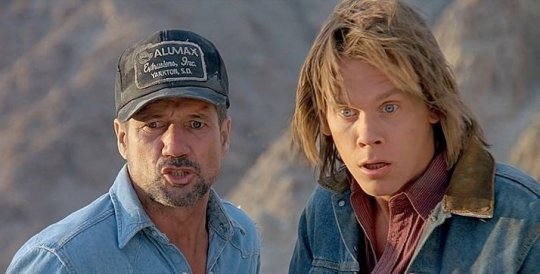
Earl Bassett: “Is this a job for an intelligent man?” Valentine McKee: “Well, show me one and I’ll ask him.”
Val and Earl are the for-hire “handymen” in the Town of Perfection (population 14), located in a vast Nevada valley surrounded by mountains from all directions. As the town’s survivalist nut Burt Gummer (more about HIM later) states: “that’s why we chose this place. Total isolation.” Besides Val and Earl, the township consists of: storeowner Walter Chang (the great Victor Wong), pottery maker Nancy (Charlotte Stewart) and her daughter Mindy (“Jurassic Park”‘s Ariana Richards), Melvin (Robert Jayne), Dr.Wallace and his wife (Conrad Bachmann and Carol Marcus – I mean, Bibi Besch), Miguel (Tony Genaro), Nestor (Richard Marcus), Old Fred (Michael Dan Wagner), Edgar Deems (Sunshine Parker) aaaand of course, the aforementioned Burt Gummer and his wife Heather (Michael Gross and Reba McEntire). Also in town is a graduate student of seismology, Rhonda LeBeck (Finn Carter), who is the EXACT opposite of everything in Val’s list, but it’s pretty obvious what’s going to happen there, isn’t it?
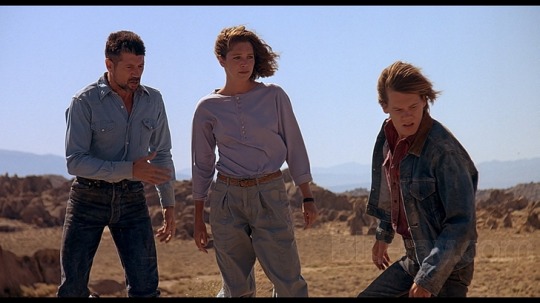
Earl Bassett: “We gotta run. We’ve got a schedule to keep.” Valentine McKee: “Yeah. See, we plan ahead, that way we don’t do anything right now. Earl explained it to me.”
But as the story begins, the number of characters begin to decrease. In fact, one of them is already gone at the point where the movie begins. As Val and Earl finally have had enough of this shit (literally, as emptying a septic tank blows in their faces), they come across Edgar Deems, sitting on top of an electrical tower. Edgar, who apparently was a town drunk, has actually died from dehydration. As the doctor diagnoses, he’s been sitting up on the tower, probably for days. Here’s the first sign, that something’s rotten in Perfection. Well, UNDER it, to be more precise.
Now, the director, Ron Underwood, does even more emulating from “Jaws” that just the poster. The underground creatures appear mostly off-camera for the longest time, much like the shark. The following attacks on people, Old Fred and the doctor and wife, are filmed very efficiently, adding mystery to the monsters while also showing their viciousness and extreme strength, as the doctors wife is sucked inside the ground while hiding inside a Ford station wagon! These creatures mean business. Also, two road-construction workers who are working on the only road in and out of town, get quickly dispatched and the resulting rock slide cuts Perfection completely off from the outside world. The scene includes a brilliant physical jackhammer gag, that’s like something right out from a Warner Brothers cartoon. And in this latest viewing I noticed, that there are a LOT of cartoon gags in the film.
Underwood is clearly using a Tex Avery-playbook in the way he shoots action, and it adds an extra level of fun to the overall tone of the film. Especially the demises (spoiler there) of each of the creatures are a carefully balanced mix of cartoon and grossness. From a creature coming in contact with concrete at full speed with a big “boink”-sound effect into the last one taking a Wile E. Coyote-swan dive off a cliff. And in the end of the second act, a creature entering “the wrong goddamn rec room” – Gummers’ basement – and getting drilled with more bullets than in your average John Woo film.
The Gummers. Ahh yes, the Gummers. Let’s talk about them for a bit.
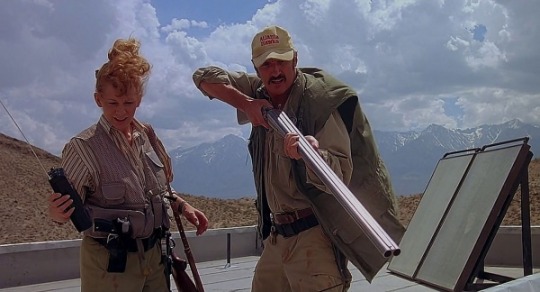
Earl Bassett: What kind of fuse is that? Burt Gummer: Cannon fuse Earl Bassett: What the hell do you use it for? Burt Gummer: My cannon!
Until “Tremors”, Michael Gross was basically known as the liberal, ex-hippie father Steven Keaton in “Family Ties”. One day after filming the last episode of that show, Gross began filming “Tremors”. Now talk about switching gears; Burt Gummer is a polar opposite of Steven Keaton. He’s a paranoid survivalist, definitely right wing, a gun nut with a capital “N”. The Gummer home is basically a bunker, set up for end-of-the-world conditions. Or as Burt states after the monster attack: “Food for five years, a thousand gallons of gas, air filtration, water filtration, Geiger counter. Bomb shelter…” That tells all about good old Burt’s world views. As does the license plate of his car: UZI 4U.
His wife Heather is played by country singer Reba McEntire in her first film performance. She does a damn good job too. Heather is likable, but also just as tough-as-nails as Burt and can certainly handle guns as well.
The creatures – Graboids, as they have been known since, in sequels and TV-series alike – are designed by Tom Woodruff and Alec Gillis’ company Amalgamated Dynamics and they are some of the best and most realistic creature work that’s been ever put on screen. Basically pre-historic worms – although the characters are trying to make up all kinds of explanations for them, from being aliens to government-built monsters to be used against invading forces. AD has worked on the “Alien”-franchise since “Aliens”, and one can see that the “double-mouth”(biting tentacle tongues shooting out from a larger mouth) has evolved from the star-beast’s similar one. These creatures are strong, fast (moving like armored freight trains underground) and smart. That is always a welcome thing in monster films. Graboids are constantly adapting, and the means that the heroes use to avoid them, don’t necessarily work for a second time. Of course they have a weakness, this time it being loud noises, as they basically sense everything by vibrations. Smart, almost “National Geographic”-approach. Nothing hokey or supernatural. Just the way I like it.
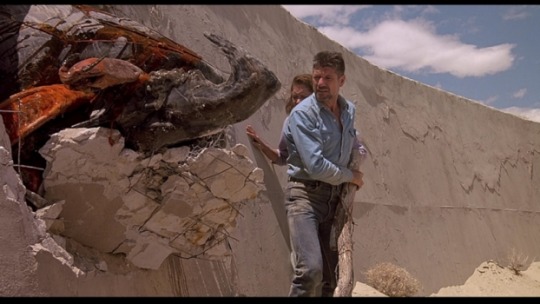
Earl Bassett: “Hey Rhonda – you ever seen anything like this before?” Valentine McKee: “Oh sure, Earl. Everyone knows about them – we just didn’t tell you.”
Pretty soon the remaining residents of the town are forced into exile, trying to escape into the mountains while pursued by the hungry beasts, the final confrontation happening on the edge of a tall canyon. “Tremors” was shot – with the exception of two sets – on location. Outside in Lone Pine, California. And you can basically SMELL the desert, and the heat, in every frame of the movie. The setting, as well as the look of the town, evokes memories of the great westerns. In fact – the third sequel for the movie IS a western, going back in time to the golden years of Perfection.
Too bad the sequels are of diminishing quality, adding unnecessary sci-fi elements (such as FLYING Graboids, WTF?) and poorer quality effects. The unifying element in the sequels (as well as the quickly cancelled after 13 episodes TV-show) is Michael Gross’ Burt. But to be absolutely frank, Burt Gummer is not a leading man. He works best in small doses. The driving force in this film is the tag team of Val & Earl, arguing, bickering, rock-paper-scissoring through near-death scenarios and finally coming up as winners (spoiler).
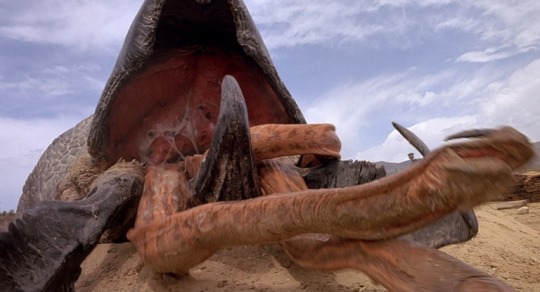
I’m sensing a pattern in my reviews (besides all so far being from 1990); “Tremors” was only a modest hit at the box office, but it went on to become a huge hit on home video and subsequent media. But as I go through my lists of great films, such seems to be the case with almost all of them. “Tremors” is funny, well-paced, beautifully shot thrill ride, with wonderful characters and rich, quotable dialogue. If that is not the sign of a cult classic, I don’t know what is. Ron Underwood proceeded to direct films like “City Slickers” (keeping up with the western tone from this film), “Heart and Souls”, “Speechless” and finally “Pluto Nash”, which basically killed his mainstream career, reducing him into mostly a TV-director.
Too bad – perhaps another low budget monster movie is what he should try again…?
3 notes
·
View notes